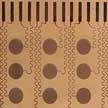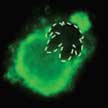Showing Spotlights 153 - 160 of 556 in category All (newest first):
 Sensory substitution with flexible electronics is one of the intriguing fields of research that takes place in nanotechnology labs around the world. In line with this focus on human senses, in the future artificial retinas integrated with the human body may not only repair damaged vision but also expand it to see a wider range wavelengths (e.g. ultraviolet light). Researchers now have demonstrated a new self-powered brain-linked vision electronic skin (e-skin) for mimicking the human retina. The general idea of our device design of brain-linked vision electronic skin is constructing an integrated flexible system including photodetector array, information analyzer, signal transmitter, and electricity power unit.
Sensory substitution with flexible electronics is one of the intriguing fields of research that takes place in nanotechnology labs around the world. In line with this focus on human senses, in the future artificial retinas integrated with the human body may not only repair damaged vision but also expand it to see a wider range wavelengths (e.g. ultraviolet light). Researchers now have demonstrated a new self-powered brain-linked vision electronic skin (e-skin) for mimicking the human retina. The general idea of our device design of brain-linked vision electronic skin is constructing an integrated flexible system including photodetector array, information analyzer, signal transmitter, and electricity power unit.
Apr 18th, 2018
 Researchers demonstrate that helical shaped magnetic nanomotors can be maneuvered inside a living cell. This new and versatile technique has the potential ability to position any payload at any desired location inside a living cell itself, which is of great importance in the field of biology and biophysics. The helical shaped nanomotors are made of mainly silica and a thin layer of magnetic material, while their size is at least ten times smaller than the cell which they enter in. A rotating magnetic field is used to drive the motors inside the cytoplasm with precise control.
Researchers demonstrate that helical shaped magnetic nanomotors can be maneuvered inside a living cell. This new and versatile technique has the potential ability to position any payload at any desired location inside a living cell itself, which is of great importance in the field of biology and biophysics. The helical shaped nanomotors are made of mainly silica and a thin layer of magnetic material, while their size is at least ten times smaller than the cell which they enter in. A rotating magnetic field is used to drive the motors inside the cytoplasm with precise control.
Apr 16th, 2018
 Researchers have demonstrated that a specific type of two-dimensional (2D) nanoparticles, nanosilicates, can grow bone and cartilage tissue from stem cells in the absence of growth factors. These nanoparticles are similar in shape to a coin, but 10 billion times smaller in size. Nanosilicates consist of minerals such as sodium, silicate, magnesium and lithium, which are already present in the body. This avoids the use of growth factors in the human body, which can generate harmful effects including unwanted tissue growth, such as a tumor.
Researchers have demonstrated that a specific type of two-dimensional (2D) nanoparticles, nanosilicates, can grow bone and cartilage tissue from stem cells in the absence of growth factors. These nanoparticles are similar in shape to a coin, but 10 billion times smaller in size. Nanosilicates consist of minerals such as sodium, silicate, magnesium and lithium, which are already present in the body. This avoids the use of growth factors in the human body, which can generate harmful effects including unwanted tissue growth, such as a tumor.
Apr 13th, 2018
 Sepsis is the body's extreme response to an infection. It is life-threatening condition in which bacteria or fungi multiply in a patient's blood - often too fast for antibiotics to help. Without timely treatment, sepsis can rapidly cause tissue damage, organ failure, and death. A critical unmet need in combating sepsis is the lack of accurate early biomarkers that can alert clinicians to a potential life-threatening situation and allow them to take preventative action. In a new study, researchers report the development of a point-of-care platform for rapid sepsis detection, called IBS (integrated biosensor for sepsis).
Sepsis is the body's extreme response to an infection. It is life-threatening condition in which bacteria or fungi multiply in a patient's blood - often too fast for antibiotics to help. Without timely treatment, sepsis can rapidly cause tissue damage, organ failure, and death. A critical unmet need in combating sepsis is the lack of accurate early biomarkers that can alert clinicians to a potential life-threatening situation and allow them to take preventative action. In a new study, researchers report the development of a point-of-care platform for rapid sepsis detection, called IBS (integrated biosensor for sepsis).
Apr 12th, 2018
 Scientists have discovered that cell sex is an important overlooked factor at the nanobio interfaces. More specifically, depending on their sex, cells respond differently to the exact same type of nanoparticles. These findings have a capacity to optimize clinical translation of nanoparticles and also to help researchers to better design and produce safe and efficient therapeutic sex-specific nanoparticles. It is likely that there are other undiscovered differences that could influence nanoparticle uptake.
Scientists have discovered that cell sex is an important overlooked factor at the nanobio interfaces. More specifically, depending on their sex, cells respond differently to the exact same type of nanoparticles. These findings have a capacity to optimize clinical translation of nanoparticles and also to help researchers to better design and produce safe and efficient therapeutic sex-specific nanoparticles. It is likely that there are other undiscovered differences that could influence nanoparticle uptake.
Mar 15th, 2018
 A popular structure for the development of nanodelivery systems are hollow tubular nanoparticles. In new work, researchers show that a hydrogel can be confined within the cavity of halloysite nanotubes (HNTs) by means of an easy strategy. The alginate network inside the HNTs cavity can be triggered by chemical stimuli (by calcium chelators) altering the kinetics, which results in the release of the cargo. This shows that halloysite with tunable hydrophilic/hydrophobic interfaces can act as nanotemplate for the synthesis of drug delivery systems based on biopolymer hydrogels.
A popular structure for the development of nanodelivery systems are hollow tubular nanoparticles. In new work, researchers show that a hydrogel can be confined within the cavity of halloysite nanotubes (HNTs) by means of an easy strategy. The alginate network inside the HNTs cavity can be triggered by chemical stimuli (by calcium chelators) altering the kinetics, which results in the release of the cargo. This shows that halloysite with tunable hydrophilic/hydrophobic interfaces can act as nanotemplate for the synthesis of drug delivery systems based on biopolymer hydrogels.
Mar 1st, 2018
 As a new member of the two-dimensional (2D) nanomaterial family, black phosphorus (BP) has attracted considerable attention in biomedicine, due to its unique physicochemical properties as well as excellent biocompatibility. Researchers have now demonstrated a novel concept of light activation of BP hydrogel to release drugs for cancer therapy. This BP hydrogel is comprised of BP nanosheets as a photosensitizer and hydrogel as a hydrophilic container for drugs. After injection, these nanosheets convert light to thermal energy when exposed to laser irradiation, leading to heating of the hydrogel matrix.
As a new member of the two-dimensional (2D) nanomaterial family, black phosphorus (BP) has attracted considerable attention in biomedicine, due to its unique physicochemical properties as well as excellent biocompatibility. Researchers have now demonstrated a novel concept of light activation of BP hydrogel to release drugs for cancer therapy. This BP hydrogel is comprised of BP nanosheets as a photosensitizer and hydrogel as a hydrophilic container for drugs. After injection, these nanosheets convert light to thermal energy when exposed to laser irradiation, leading to heating of the hydrogel matrix.
Feb 27th, 2018
 From interaction with bacteria, propulsion based on cells, in vivo medical applications to even intracellular applications, the rapidly expanding development of micro- and nanomachines with sizes comparable to or even smaller than mammalian cells, has led this field to advance from understanding of basic motion mechanisms to applications in living biosystems. A recent review highlights the recent efforts for and toward application of micro/nanomachines in living biosystems, including microorganisms, biological cells, and human body. Applications of micro- and nanomachines in living biosystems are reviewed from two aspects: their interaction with other microscopic organisms or biological units, and the efforts toward their application in the human body.
From interaction with bacteria, propulsion based on cells, in vivo medical applications to even intracellular applications, the rapidly expanding development of micro- and nanomachines with sizes comparable to or even smaller than mammalian cells, has led this field to advance from understanding of basic motion mechanisms to applications in living biosystems. A recent review highlights the recent efforts for and toward application of micro/nanomachines in living biosystems, including microorganisms, biological cells, and human body. Applications of micro- and nanomachines in living biosystems are reviewed from two aspects: their interaction with other microscopic organisms or biological units, and the efforts toward their application in the human body.
Jan 30th, 2018
 Sensory substitution with flexible electronics is one of the intriguing fields of research that takes place in nanotechnology labs around the world. In line with this focus on human senses, in the future artificial retinas integrated with the human body may not only repair damaged vision but also expand it to see a wider range wavelengths (e.g. ultraviolet light). Researchers now have demonstrated a new self-powered brain-linked vision electronic skin (e-skin) for mimicking the human retina. The general idea of our device design of brain-linked vision electronic skin is constructing an integrated flexible system including photodetector array, information analyzer, signal transmitter, and electricity power unit.
Sensory substitution with flexible electronics is one of the intriguing fields of research that takes place in nanotechnology labs around the world. In line with this focus on human senses, in the future artificial retinas integrated with the human body may not only repair damaged vision but also expand it to see a wider range wavelengths (e.g. ultraviolet light). Researchers now have demonstrated a new self-powered brain-linked vision electronic skin (e-skin) for mimicking the human retina. The general idea of our device design of brain-linked vision electronic skin is constructing an integrated flexible system including photodetector array, information analyzer, signal transmitter, and electricity power unit.
 Subscribe to our Nanotechnology Spotlight feed
Subscribe to our Nanotechnology Spotlight feed





